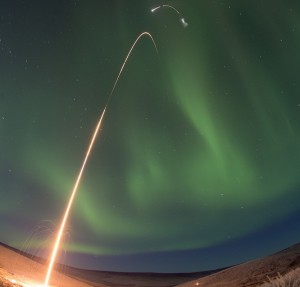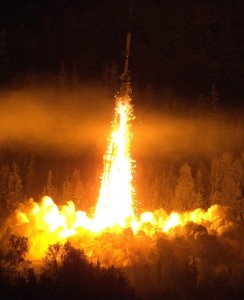
Image Credit: NASA/Jamie Adkins
On day 15, of the 15-day window for five launches of sub-orbital sounding rockets saw the launch of the Aural Spatial Structures Probe, or ASSP aboard a NASA Oriole IV sounding rocket at 1:41 am on Wednesday from the Poker Flat Research Range in interior Alaska. According to NASA,”preliminary data show that all aspects of the payload worked as designed and the principal investigator Charles Swenson at Utah State University described the mission as a “raging success.”
“This is likely the most complicated mission the sounding rocket program has ever undertaken and it was not easy by any stretch,” said John Hickman, operations manager of the NASA sounding rocket program office at the Wallops Flight Facility, Virginia. “It was technically challenging every step of the way.”
“The payload deployed all six sub-payloads in formation as planned and all appeared to function as planned. Quite an amazing feat to maneuver and align the main payload, maintain the proper attitude while deploying all six 7.3-pound sub payloads at about 40 meters per second,” said Hickman.

Image Credit: NASA/Lee Wingfield
The Wednesday launch was preceded by a launch of four other payloads on Monday, NASA said. On Monday, an M-Tex, or Mesosphere-Lower Thermosphere Turbulance experiment, aboard a NASA Terrier-Improved Malemute sounding rocket, launched at 13 minutes after midnight and was followed by a launch of a second payload one minute later. The second payload a MIST, or Mesospheric Inversion-layer Stratified Turbulance experiment, was aboard a NASA Terrier-Improved Orion rocket.
At 1:46 am, a second M-Tex experiment was lainched, followed a minute later by a second MIST payload.
The launches were made to better understand the interaction of solar winds and the earth’s atmosphere that produce Northern Lights, or Auroras.
The Mesosphere-Lower Thermosphere Turbulence Experiment (MTeX), in conjunction with the Mesospheric Inversion-layer Stratified Turbulence (MIST) explores the Earth’s atmosphere’s response to auroral, radiation belt and solar energetic particles and associated effects on nitric oxide and ozone, says NASA.
